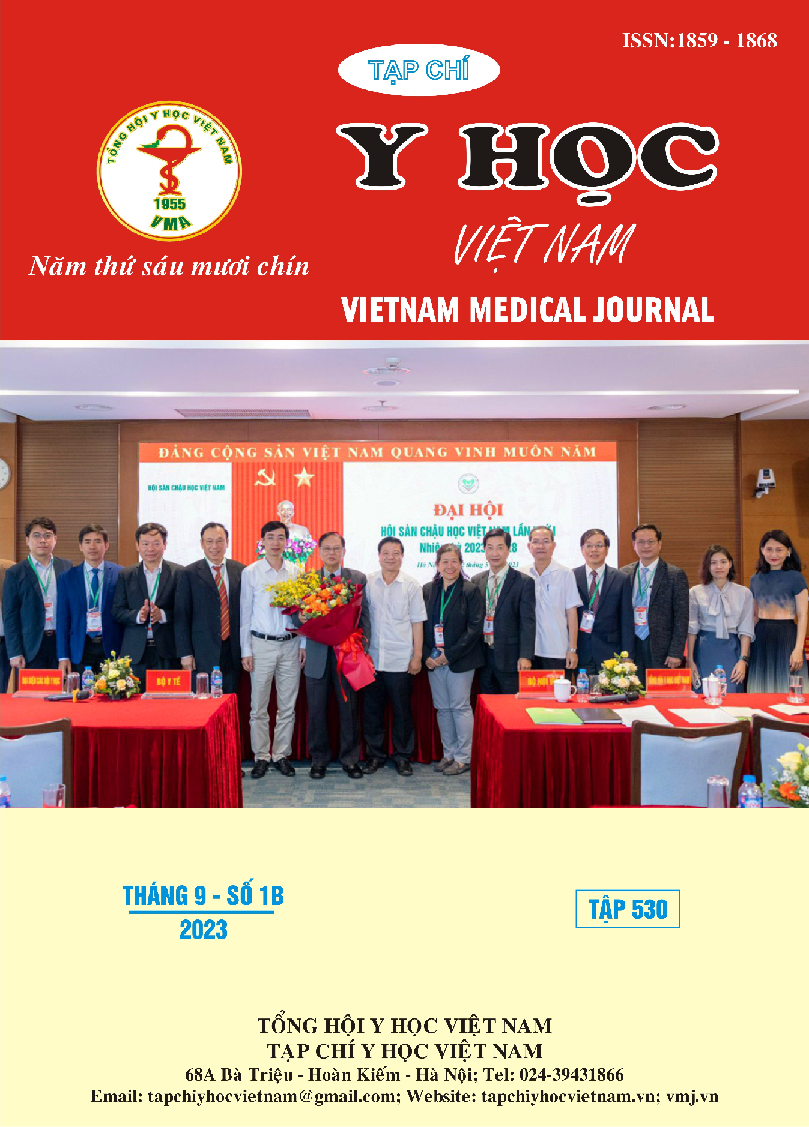RESULTS OF TREATMENT FOR CLEAR CELL OVARIAN CANCER WITH PACLITAXEL-CARBOPLATIN REGIMEN
Main Article Content
Abstract
Objective: To evaluate some clinical and paraclinical characteristics of patients with clear cell ovarian cancer treated with the paclitaxel-carboplatin regimen, the progression-free survival (PFS) of the study group, and the toxicity assessment of the regimen. Method: This was a cluster case study, with a study population of 53 patients with clear cell ovarian cancer treated with the paclitaxel-carboplatin regimen at Vietnam National Cancer Hospital from January 2015 to January 2023. Results: The mean age of the study subjects was 53.2 ± 1.45 years. The most common functional symptom was lower abdominal distension (77.4%), and the most common physical sign was palpable abdominal mass (81.1%). The most frequent sonographic features suggestive of malignancy were irregular wall (45.3%), papillary projection into the cyst (34.0%), and abdominal fluid (32.1%). At the time of diagnosis, 14.6% of patients had normal serum CA 125 levels, and 23.5% had normal serum HE4 levels. According to FIGO staging, the majority of patients were in stage II (41.5%), with the lowest proportion in stage I (15.1%). Stages III and IV had relatively higher proportions (22.6% and 20.8%, respectively). The 3-year progression-free survival rate (PFS) was found to be 64.2%. The 3-year PFS rate decreased progressively across disease stages, with statistically significant differences (p=0.000). Age, ultrasound tumor size, serum CA 125 levels, and serum HE4 levels did not show significant differences in 3-year PFS rates. Commonly encountered adverse effects were leukopenia, anemia, and thrombocytopenia, primarily at grades 1-2. The most common grade 3-4 toxicity was neutropenia (22.7%). Conclusion: The paclitaxel-carboplatin chemotherapy regimen is effective and well-tolerated in the treatment of patients with clear cell ovarian cancer.
Article Details
Keywords
clear cell ovarian cancer, paclitaxel-carboplatin, clinical characteristics, paraclinical characteristics, progression-free survival, toxicity.
References
2. Pozzati, F. et al. "Imaging in gynecological disease (14): clinical and ultrasound characteristics of ovarian clear cell carcinoma", Ultrasound Obstet Gynecol. 2018,52(6), 792-800.
3. Shuqing, L., Zhiling, Z. "Patients with stage IA ovarian clear cell carcinoma do not require chemotherapy following surgery", Cancer Med. 2023, 12(6), 6668-6674.
4. Sirichaisutdhikorn, D., Suprasert, P. và Khunamornpong, S. "Clinical outcome of the ovarian clear cell carcinoma compared to other epithelial ovarian cancers when treated with paclitaxel and carboplatin", Asian Pac J Cancer Prev. 2009,10(6), 1041-5.
5. Sun, M., Jiang, W. "Ovarian clear cell carcinoma with or without endometriosis origin in a single institution cohort", Discov Oncol. 2023, 14(1), 39.
6. Sung, H. et al. "Global Cancer Statistics 2020: GLOBOCAN Estimates of Incidence and Mortality Worldwide for 36 Cancers in 185 Countries", CA Cancer J Clin. 2021,71(3), 209-249.
7. Zhou, L. et al. "Ovarian endometrioid carcinoma and clear cell carcinoma: A 21-year retrospective study", J Ovarian Res. 2021,14(1), 63.
8. Zhu, C. và các cộng sự. "Updates of Pathogenesis, Diagnostic and Therapeutic Perspectives for Ovarian Clear Cell Carcinoma", J Cancer. 2021,12(8), 2295-2316.


